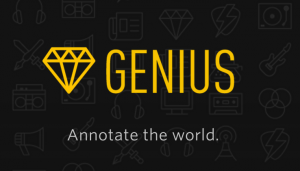Part of my ongoing attempt to teach my students how to write in this century involves finding different platforms and hopefully audiences for them to write from. I am on the lookout for places in the digital world they voluntarily write. Where are the cool kids writing from? I say “from” because I’ve recently learned that when they write, my students don’t think about the audience. They think about the platform–Eli Review, Google docs, Tumblr, Twitter, and now Genius. They assign traits to the platform and then tailor their writing to the demands and pressures (their word) of the platform.
I’ve never thought of web publishing platforms like this. As a writer and teacher, I try to think about people who might be using those sites and how I can best communicate with them. That’s how I was taught, and so it was how I was teaching my students. But it turns out that they don’t think like that. I ask my students who’s looking at their work and they reply with the name of the site.
 This reality came to light during a class where I was talking about how we’re going to be using the site Genius.com to collaborate with a class from another state to annotate and talk about Macbeth. Genius is a social annotation site that covers multiple arenas: rock lyrics, rap lyrics, literature, law, news, film, etc. A colleague from South Dakota, Marissa Kleinhans, heard about the site at the South Dakota Council of Teachers of English conference and proposed that our classes collaborate on a piece of text. I’d never heard of the site, which started out as a place for Rap enthusiasts to annotate songs and squabble over references and word origins, activities not so different from what we do in class with literature. Posting to the site means fundamentally engaging in a close read. Mrs. Kleinhans and I had created collaborative activities using Google documents in the past. The idea behind Genius.com feels very much the same.
This reality came to light during a class where I was talking about how we’re going to be using the site Genius.com to collaborate with a class from another state to annotate and talk about Macbeth. Genius is a social annotation site that covers multiple arenas: rock lyrics, rap lyrics, literature, law, news, film, etc. A colleague from South Dakota, Marissa Kleinhans, heard about the site at the South Dakota Council of Teachers of English conference and proposed that our classes collaborate on a piece of text. I’d never heard of the site, which started out as a place for Rap enthusiasts to annotate songs and squabble over references and word origins, activities not so different from what we do in class with literature. Posting to the site means fundamentally engaging in a close read. Mrs. Kleinhans and I had created collaborative activities using Google documents in the past. The idea behind Genius.com feels very much the same.
I had Genius.com projected on the screen while talking about expectations when I asked my students what they thought about the idea. It was a casual question. I wasn’t delving, and I didn’t expect that it would cause a wave of raised hands and excited chatter, but that’s what happened. It seemed like they all had something to say. I grabbed a notebook, unobtrusively I hoped, as I didn’t want to Heisenberg all over whatever was happening.
 What they said was that they liked Genius.com because it was “cool.” Great, what do I do with that? The quest for “cool” has always meant “cool until the adults find out about it” and that’s not what I’m looking for. But as I listened more closely, I heard them say other things. They talked about the design of the site, how the black background and yellow font was code to them that said something about the audience and what was expected. It was “looser” and “more casual,” which again was code that meant that they could write “like themselves.” They were talking about voice, authenticity, honesty. To my teacher’s ears, “like themselves,” too often meant sloppy arguments, careless grammar and generally bad writing–all the things I am trying to educate out of them. And sometimes it does mean that, but what they were talking about was the freedom to use their own authentic voices. They were talking about the freedom to take risks without being judged, not just by their teacher, but by the site itself.
What they said was that they liked Genius.com because it was “cool.” Great, what do I do with that? The quest for “cool” has always meant “cool until the adults find out about it” and that’s not what I’m looking for. But as I listened more closely, I heard them say other things. They talked about the design of the site, how the black background and yellow font was code to them that said something about the audience and what was expected. It was “looser” and “more casual,” which again was code that meant that they could write “like themselves.” They were talking about voice, authenticity, honesty. To my teacher’s ears, “like themselves,” too often meant sloppy arguments, careless grammar and generally bad writing–all the things I am trying to educate out of them. And sometimes it does mean that, but what they were talking about was the freedom to use their own authentic voices. They were talking about the freedom to take risks without being judged, not just by their teacher, but by the site itself.
It seems that “academic” sites, like Eli.review, look academic or, as one student put it, “like academic trying to be cool,” and that academic feel puts different pressures on the writing. The same thing happens whenever I set up a task for them on Google docs–reviews, feedback, backchanneling–the assignment didn’t matter. What mattered to them was that I, or another academic, had set it up for the purpose of teaching writing, and they were acutely aware of that and it affected how they wrote.
 Keep in mind that I use both of these platforms (Google Docs and Eli Review) as places for my students to interact with each others’ writing and ideas. I have been alternately pleased and frustrated by the results. But it had never occurred to me that although I expressly told them that they were to engage with each other–that their classmates were the audience–they felt pressure from me. Not because I said anything, but because I had created the space, given it my traits, so the space itself was whispering requirements to them, telling them that their writing had to be “schooly.” Years of schooling have taught them that school writing has strict requirements. That to be “scholarly” and “academic” they had to strip the personality, the voice, out of their writing. This lesson has become so ingrained that they could sense it lurking in these academic sites, and they weren’t about to be fooled into authenticity. They certainly didn’t trust me when I said anything to the contrary. The site told them the truth–that outside of creative writing in school, they had to be academic–dry and in many ways false.
Keep in mind that I use both of these platforms (Google Docs and Eli Review) as places for my students to interact with each others’ writing and ideas. I have been alternately pleased and frustrated by the results. But it had never occurred to me that although I expressly told them that they were to engage with each other–that their classmates were the audience–they felt pressure from me. Not because I said anything, but because I had created the space, given it my traits, so the space itself was whispering requirements to them, telling them that their writing had to be “schooly.” Years of schooling have taught them that school writing has strict requirements. That to be “scholarly” and “academic” they had to strip the personality, the voice, out of their writing. This lesson has become so ingrained that they could sense it lurking in these academic sites, and they weren’t about to be fooled into authenticity. They certainly didn’t trust me when I said anything to the contrary. The site told them the truth–that outside of creative writing in school, they had to be academic–dry and in many ways false.
Genius.com whispers different things to my students. Besides the cool yellow font (I could do that), the masthead (Don’t call it that–makes it instantly less cool.) lists all of the different types of texts being annotated, and it puts “Lit” third in line behind Rap and Rock, but ahead of News, Pop, and several others. My students said that putting Lit with those others made them think that what we were doing “might be relevant,” because their work was part of what was happening on this site, and it was happening alongside of other relevant work. This site, the people using it, put what they cared about next to other serious work being done by serious people.
It’s important to note that the annotations we worked on were not public. I set up a private space for us to work in so that the only outside audience and collaborators were the South Dakotan students and the occasional monitor from the genius.com staff. My students’ work was being seen by the same people who had always seen their work. Their audience, at least as I saw it, hadn’t changed. But here again, they think about the site and the audience as one thing. They also said that the presence of those non-academic topics made it clear to them that they could “loosen up” and “be themselves.” I’m only asking them to annotate a text so I can see what they’re thinking, but even that carries some pressure when it’s their teacher asking them to do it in an “academic space.” This different space tells them that it’s alright to take chances, to be wrong, to be smart. Genius.com tells them what it wants them to be and how to write for it.
That this same thing might occur in other sites leads me to think that I am talking about audience in the wrong way. Rather than me, as teacher, creating digital space for my students to write and then talking about the audience that we bring to that space, I need to work harder to find spaces that communicate their demands and figure out how to read those spaces myself. In truth, I have no idea how to do that. This presents me with significant challenges and questions, but I think the first thing I need to think about is broadening my ideas about writing. Am I locked into “school” writing forms that are forcing many of my students away from their own voices? I honestly thought that a digital space would be freeing for my digital natives, but it turns out I need to listen harder.
 Rick Kreinbring teaches English at Avondale High School in Auburn Hills, Michigan. His current assignments include teaching AP Language and Composition and AP Literature and Composition. He is a member of a statewide research project through the Michigan Teachers as Researchers Collaborative partnered with the MSU Writing in Digital Environments Program, which concentrates on improving student writing and peer feedback. Rick has presented at the National Advanced Placement Convention and the National Council of Teachers of English Conference. He is in his twenty-third year of teaching and makes his home in Huntington Woods.
Rick Kreinbring teaches English at Avondale High School in Auburn Hills, Michigan. His current assignments include teaching AP Language and Composition and AP Literature and Composition. He is a member of a statewide research project through the Michigan Teachers as Researchers Collaborative partnered with the MSU Writing in Digital Environments Program, which concentrates on improving student writing and peer feedback. Rick has presented at the National Advanced Placement Convention and the National Council of Teachers of English Conference. He is in his twenty-third year of teaching and makes his home in Huntington Woods.


 The writer’s notebook is almost a sacred, mythical element of the writer’s workshop. It is where students’ writing lives take shape and are documented over the course of a year. In my classroom, the writer’s notebook held everything, and I mean EVERYTHING. Any paper I handed out was immediately taped or glued into the notebook, even if it had to be turned on its side or folded over two times. The writer’s notebook was our textbook. So when I heard each one of my students would be getting a Chromebook, I was excited about the possibilities and what that could mean for student writing. But what nagged at me was the loss of the traditional, tangible writer’s notebook.
The writer’s notebook is almost a sacred, mythical element of the writer’s workshop. It is where students’ writing lives take shape and are documented over the course of a year. In my classroom, the writer’s notebook held everything, and I mean EVERYTHING. Any paper I handed out was immediately taped or glued into the notebook, even if it had to be turned on its side or folded over two times. The writer’s notebook was our textbook. So when I heard each one of my students would be getting a Chromebook, I was excited about the possibilities and what that could mean for student writing. But what nagged at me was the loss of the traditional, tangible writer’s notebook. Instead of kids bringing their notebooks to one another and reluctantly allowing a partner to write on their prized draft, kids are sharing documents with one another and setting the editing level based on their comfort, with many choosing to only allow their partners to comment on a document. They no longer have to worry that someone is going to “mess up” their paper. They can simply focus on the comments, and especially relish hitting the “Resolve” button when they have revised something. I think it’s more than just reading the comments and making changes, though; kids are having conversations via their comments about writing as well as having conversations about their writing out loud. The conversations about writing are multilayered. If you’ve ever seen a teen text and talk to someone at the same time, you know that holding multiple conversations on various platforms is a way of life. And students also seem to be more responsive to my suggestions because my comments don’t physically change their writing; they are seen as just that: comments and suggestions.
Instead of kids bringing their notebooks to one another and reluctantly allowing a partner to write on their prized draft, kids are sharing documents with one another and setting the editing level based on their comfort, with many choosing to only allow their partners to comment on a document. They no longer have to worry that someone is going to “mess up” their paper. They can simply focus on the comments, and especially relish hitting the “Resolve” button when they have revised something. I think it’s more than just reading the comments and making changes, though; kids are having conversations via their comments about writing as well as having conversations about their writing out loud. The conversations about writing are multilayered. If you’ve ever seen a teen text and talk to someone at the same time, you know that holding multiple conversations on various platforms is a way of life. And students also seem to be more responsive to my suggestions because my comments don’t physically change their writing; they are seen as just that: comments and suggestions.  I had toyed with the idea of having students use a single, running Google Doc to keep a notebook, but that doesn’t work as easily as a traditional notebook does, especially when using Google Classroom, because some of the documents would be in Classroom and some would be in the running Google Doc. I thought toggling between the two would be difficult. Obviously, no single platform seems to be perfect (it’s unlikely that anything will ever meet every need/want). Despite the misgivings I may have, my students do not seem to be having the same internal struggles that I am having. Using their Chromebooks has quickly become second nature, with the biggest complaint being that the WiFi isn’t working quickly enough!
I had toyed with the idea of having students use a single, running Google Doc to keep a notebook, but that doesn’t work as easily as a traditional notebook does, especially when using Google Classroom, because some of the documents would be in Classroom and some would be in the running Google Doc. I thought toggling between the two would be difficult. Obviously, no single platform seems to be perfect (it’s unlikely that anything will ever meet every need/want). Despite the misgivings I may have, my students do not seem to be having the same internal struggles that I am having. Using their Chromebooks has quickly become second nature, with the biggest complaint being that the WiFi isn’t working quickly enough! ianna Taylor is an ELA and Title 1 teacher at Orchard Lake Middle School in West Bloomfield. She is a member of the AVID Site Team and Continuous School Improvement Team at her school, among other things. She is also a
ianna Taylor is an ELA and Title 1 teacher at Orchard Lake Middle School in West Bloomfield. She is a member of the AVID Site Team and Continuous School Improvement Team at her school, among other things. She is also a 
 Next week, we’ll spend a day in class where they’ll look at their past essays and really read my comments (a girl can dream, right?). Then they’ll talk about those essays with each other and set some goals for this next piece. I’m hoping the goals will be more like “I will make sure my analysis in my body paragraphs directly relates to my thesis” and less like “I will get an A.” We’ll see. One way I hope to get at this is some reflective journaling throughout the process. We’ll set the goals at the beginning of the process, but then I’m going to ask the students to revisit those goals throughout the writing process. What have they done to achieve those goals? What struggles are they having? Hopefully, by asking them to articulate their progress, they’ll begin to realize that they are the ones in control of improving their writing.
Next week, we’ll spend a day in class where they’ll look at their past essays and really read my comments (a girl can dream, right?). Then they’ll talk about those essays with each other and set some goals for this next piece. I’m hoping the goals will be more like “I will make sure my analysis in my body paragraphs directly relates to my thesis” and less like “I will get an A.” We’ll see. One way I hope to get at this is some reflective journaling throughout the process. We’ll set the goals at the beginning of the process, but then I’m going to ask the students to revisit those goals throughout the writing process. What have they done to achieve those goals? What struggles are they having? Hopefully, by asking them to articulate their progress, they’ll begin to realize that they are the ones in control of improving their writing. Student-led modeling: I often write my own essay along with my students a la Penny Kittle’s
Student-led modeling: I often write my own essay along with my students a la Penny Kittle’s  Hattie Maguire is an English teacher and Content Area Leader at Novi High School. She is spending her fourteenth year in the classroom teaching AP English Language and Composition, English 10, Debate, and Practical Public Speaking. She is a National Board Certified Teacher who earned her BS in English and MA in Curriculum and Teaching from Michigan State University.
Hattie Maguire is an English teacher and Content Area Leader at Novi High School. She is spending her fourteenth year in the classroom teaching AP English Language and Composition, English 10, Debate, and Practical Public Speaking. She is a National Board Certified Teacher who earned her BS in English and MA in Curriculum and Teaching from Michigan State University.